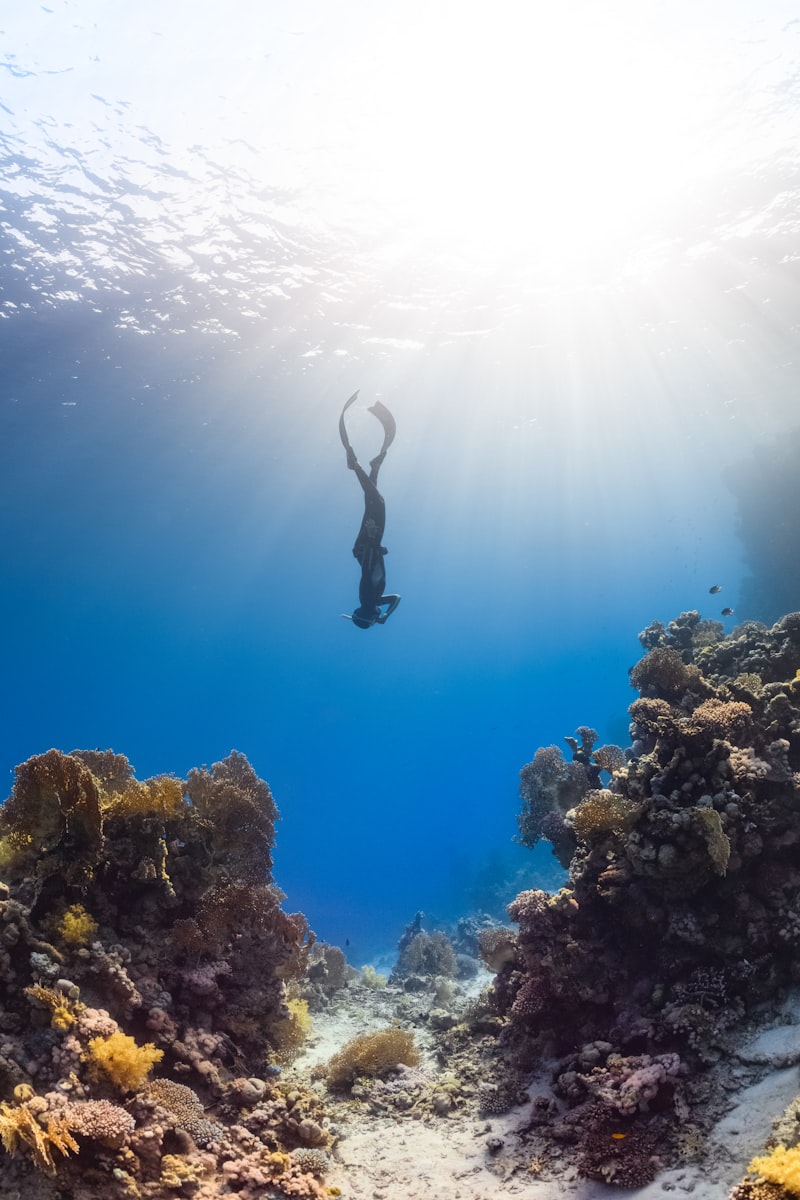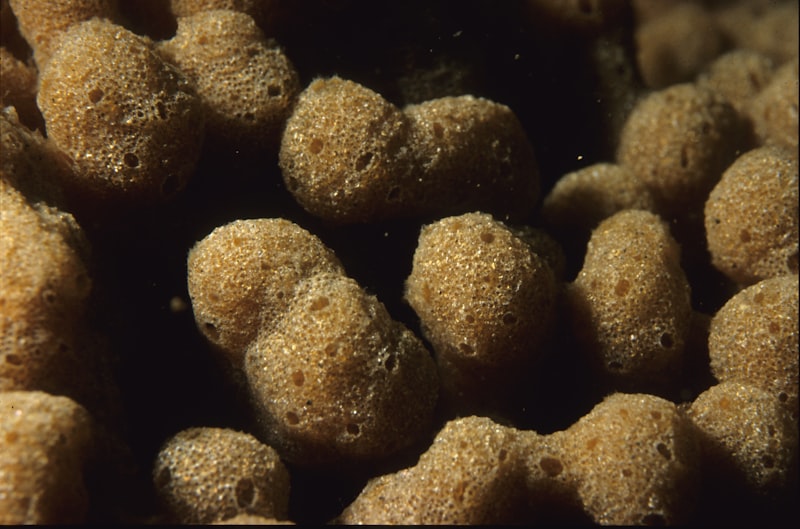Imagine a bustling city beneath the waves, where every nook and cranny is occupied by a multitude of creatures, each playing their part in the intricate web of life. Coral reefs, built by tiny coral polyps over centuries, provide homes and hiding places for countless species of fish, crustaceans, and other marine organisms. They are often likened to underwater rainforests for their biodiversity and importance to global ecology.
What makes coral reefs truly awe-inspiring is their kaleidoscope of colors. From vibrant blues and greens to deep reds and oranges, the reef’s inhabitants and their surroundings create a mesmerizing palette that attracts divers and researchers alike. This vibrant display isn’t just for show; it serves as a survival mechanism for the corals themselves, who rely on their vivid hues to attract symbiotic algae that provide essential nutrients through photosynthesis.

But beyond their visual appeal, coral reefs are vital to our planet’s health. They act as natural barriers, protecting coastlines from erosion and storm damage. In addition, they support fisheries that provide food and livelihoods for millions of people worldwide. Economically, coral reefs contribute billions of dollars annually through tourism, fishing, and pharmaceutical discoveries.
However, these invaluable ecosystems are under threat from climate change, overfishing, pollution, and coastal development. Rising sea temperatures cause coral bleaching, where corals expel the algae living in their tissues, leading to widespread coral death and ecosystem collapse. Conservation efforts are crucial to preserving these fragile ecosystems for future generations.
Exploring the Hidden Marvels: Coral Reef Biodiversity Unveiled
Coral reefs are not just colorful underwater landscapes; they are vibrant ecosystems teeming with life, making them some of the most biodiverse environments on Earth. These underwater marvels are home to a staggering array of marine species, each playing a crucial role in maintaining the delicate balance of the reef ecosystem.
Imagine diving into the crystal-clear waters of a coral reef and being greeted by a kaleidoscope of colors. The corals themselves, often mistaken for rocks, are living organisms that provide shelter and food for countless marine species. From tiny fish darting among the branches to majestic sea turtles gliding gracefully above, every corner of the reef pulsates with life.
One of the most awe-inspiring aspects of coral reefs is their biodiversity. Despite covering less than 1% of the ocean floor, coral reefs support about 25% of all marine species. This diversity is not just limited to fish and corals; it extends to an astonishing variety of invertebrates, algae, and microorganisms that form complex and interconnected food webs.
Each species within the coral reef ecosystem plays a specific role. Predators like sharks and barracudas help control populations of smaller fish, preventing any one species from dominating. Meanwhile, herbivorous fish like parrotfish keep algae growth in check, allowing coral larvae to settle and thrive. Even the tiniest creatures, like plankton and shrimp, contribute to the reef’s health by recycling nutrients and providing food for larger predators.
However, coral reefs face numerous threats, primarily due to human activities. Climate change, overfishing, pollution, and coastal development all contribute to coral reef degradation. As these fragile ecosystems decline, so too does the biodiversity they support, endangering countless marine species that rely on them for survival.
Preserving Paradise: Challenges and Triumphs in Coral Reef Conservation
Coral reefs, often dubbed the “rainforests of the sea,” are not only breathtakingly beautiful but also crucial for marine biodiversity and coastal protection. These vibrant ecosystems teem with life, supporting a quarter of all marine species despite covering less than 1% of the ocean floor. However, they face unprecedented threats, ranging from climate change to pollution and overfishing.
Climate change stands as one of the foremost challenges to coral reef survival. Rising ocean temperatures lead to coral bleaching, a phenomenon where corals expel the colorful algae living in their tissues, causing them to turn ghostly white and making them more susceptible to disease. This devastating process has already affected reefs worldwide, causing widespread damage to once-thriving ecosystems.
Pollution, particularly from agricultural runoff and plastic waste, poses another significant threat. Excess nutrients can trigger algal blooms that smother corals, while plastic debris can entangle marine life or be ingested, disrupting entire food chains. The impact is not only ecological but also economic, as reefs support lucrative tourism and fisheries industries in many regions.
Despite these challenges, there are inspiring stories of conservation efforts yielding positive results. Marine protected areas (MPAs) have been established to safeguard vulnerable reefs, restricting activities like fishing and anchoring to allow damaged ecosystems time to recover. Additionally, community-based initiatives empower local stakeholders to take ownership of reef conservation, promoting sustainable practices and raising awareness about the importance of preserving these fragile habitats.
Innovative technologies also offer hope for the future of coral reefs. From coral nurseries that propagate resilient species to artificial intelligence monitoring systems that detect early signs of coral stress, scientists and conservationists are harnessing cutting-edge tools to better understand and protect these invaluable ecosystems.
As we navigate the complexities of coral reef conservation, one thing remains clear: the fate of these underwater wonders depends on collective action. By reducing our carbon footprint, supporting sustainable seafood choices, and advocating for stronger environmental policies, we can contribute to preserving paradise beneath the waves for future generations to marvel at and cherish.
The Underwater Symphony: Life and Color in Coral Reefs
These underwater marvels are built by tiny creatures called coral polyps, which tirelessly construct intricate calcium carbonate skeletons over centuries. These structures provide homes and shelter for a myriad of marine species, from dazzling fish in every hue imaginable to graceful sea turtles gliding effortlessly through the cerulean waters. The reefs pulsate with activity as schools of fish dart among the corals, creating a ballet of movement and color.

But the beauty of coral reefs extends beyond their aesthetic appeal. They are vital ecosystems that support over 25% of all marine life, despite covering less than 1% of the ocean floor. In addition to providing habitats for marine organisms, reefs protect coastlines from erosion and storm damage, and contribute to local economies through tourism and fisheries.
However, these underwater paradises face unprecedented threats. Climate change, pollution, overfishing, and destructive fishing practices endanger the delicate balance of coral ecosystems worldwide. Bleaching events, caused by rising ocean temperatures, can lead to mass coral mortality and devastating consequences for associated marine life.
Yet, hope remains. Conservation efforts, marine protected areas, and sustainable practices offer a lifeline to these invaluable ecosystems. By raising awareness and taking collective action, we can preserve the richness and diversity of coral reefs for future generations to marvel at and enjoy.
Climate Change Threats: Can Coral Reefs Adapt and Survive?
Climate change poses a significant threat to coral reefs worldwide. These diverse underwater ecosystems, teeming with life and color, face increasing challenges as ocean temperatures rise and weather patterns become more erratic. The question on many scientists’ minds is whether coral reefs can adapt quickly enough to survive these changing conditions.
Coral reefs are incredibly resilient but are now facing unprecedented stress. Rising sea temperatures lead to coral bleaching, where corals expel the algae living in their tissues, turning them white and depriving them of their main energy source. This phenomenon weakens the corals and makes them more susceptible to diseases and death.
The acidity of ocean waters is also increasing as they absorb more carbon dioxide from the atmosphere. This acidification makes it harder for corals to build their calcium carbonate skeletons, essential for their structure and growth. Without healthy reefs, marine biodiversity suffers, affecting countless species that rely on coral habitats for food and shelter.

Despite these challenges, there is hope that some coral species may be able to adapt. Scientists are studying resilient corals that have shown the ability to withstand higher temperatures or recover from bleaching events. They are looking into whether these resilient traits can be passed on to future generations through genetic adaptation.
Additionally, conservation efforts play a crucial role in protecting coral reefs. Marine protected areas, sustainable fishing practices, and reducing pollution all contribute to healthier reef ecosystems. Community involvement and education are also essential in raising awareness about the importance of coral reefs and the need for their conservation.
While coral reefs face daunting challenges from climate change, there are ongoing efforts to understand and mitigate these threats. Whether corals can adapt and survive in the long term remains a critical question that scientists are actively researching. By taking proactive steps to reduce carbon emissions and protect marine environments, we can help ensure a future where coral reefs continue to thrive as vibrant centers of ocean life.
Beyond Beauty: Coral Reefs as Crucial Global Ecosystems
Imagine snorkeling through crystal-clear waters, surrounded by a kaleidoscope of colors—vibrant corals of all shapes and sizes, dancing fish in every hue imaginable, and curious sea turtles gliding effortlessly. This is the enchanting world of coral reefs, where beauty meets functionality in the most spectacular fashion.
But beyond their aesthetic allure, coral reefs serve as crucial lifelines for both marine organisms and human populations alike. They act as natural barriers, protecting coastlines from erosion and storm surges—a shield against the relentless power of the ocean. In fact, many coastal communities depend on healthy reefs for their livelihoods, whether through fishing, tourism, or shoreline protection.
Moreover, coral reefs are indispensable to the global carbon cycle. Although they occupy less than 0.1% of the ocean floor, they are responsible for around 25% of all marine life, including fish, mollusks, and other marine creatures. They also provide a crucial habitat for thousands of species, providing food, shelter, and breeding grounds for countless marine organisms.
Unfortunately, coral reefs face an array of threats today, ranging from climate change and ocean acidification to overfishing and pollution. Rising sea temperatures cause coral bleaching, a phenomenon where corals expel the symbiotic algae that provide them with nutrients and color, leaving them vulnerable to disease and death.
Conservation efforts are underway globally to protect and restore these invaluable ecosystems. Initiatives such as marine protected areas, sustainable fishing practices, and reducing pollution are crucial steps towards safeguarding coral reefs for future generations. Through collective action and awareness, we can ensure that these extraordinary ecosystems continue to thrive, supporting both marine biodiversity and human well-being in the face of mounting challenges.
Frequently Asked Questions
What are the main threats to coral reef ecosystems?
Learn about the primary threats facing coral reef ecosystems, including climate change, ocean acidification, overfishing, pollution, and coral bleaching. Understand how these factors impact reef health and biodiversity.
What makes coral reefs so diverse and vibrant?
Discover why coral reefs are incredibly diverse and vibrant due to their complex ecosystems that support a myriad of marine life. Factors like symbiotic relationships with algae, unique adaptations to nutrient-poor waters, and intricate habitats contribute to their stunning biodiversity.
How can we protect coral reefs from climate change?
Learn how to protect coral reefs from climate change by reducing carbon emissions, supporting sustainable fishing practices, promoting marine protected areas, and raising awareness about coral conservation.
Why are coral reefs important for coastal communities?
Discover why coral reefs are crucial for coastal communities, providing essential protection against storms and erosion while supporting local economies through fisheries and tourism.
How do coral reefs support marine biodiversity?
Learn how coral reefs support marine biodiversity by providing habitats for countless species, offering food and shelter, and contributing to the overall health of ocean ecosystems.



